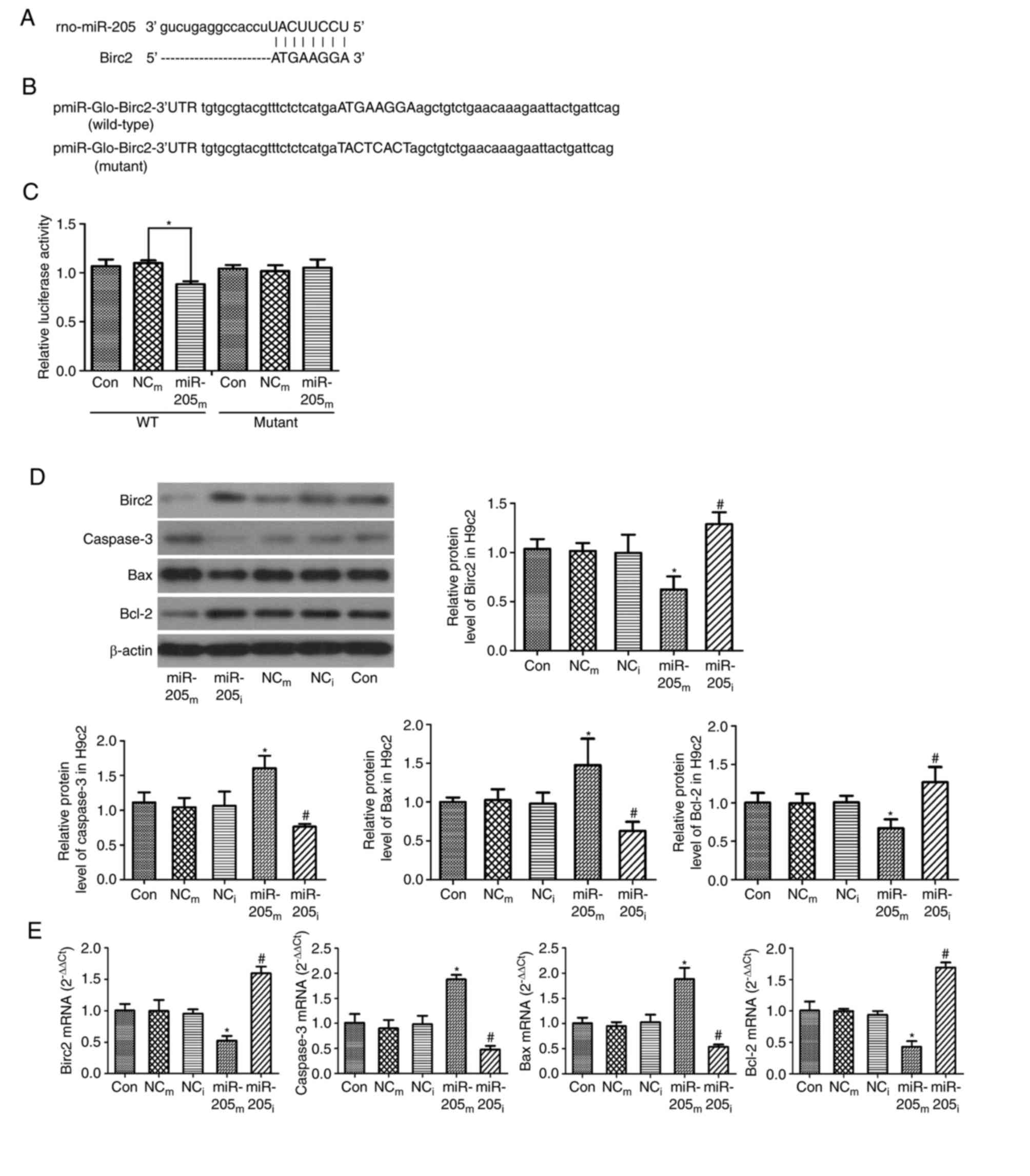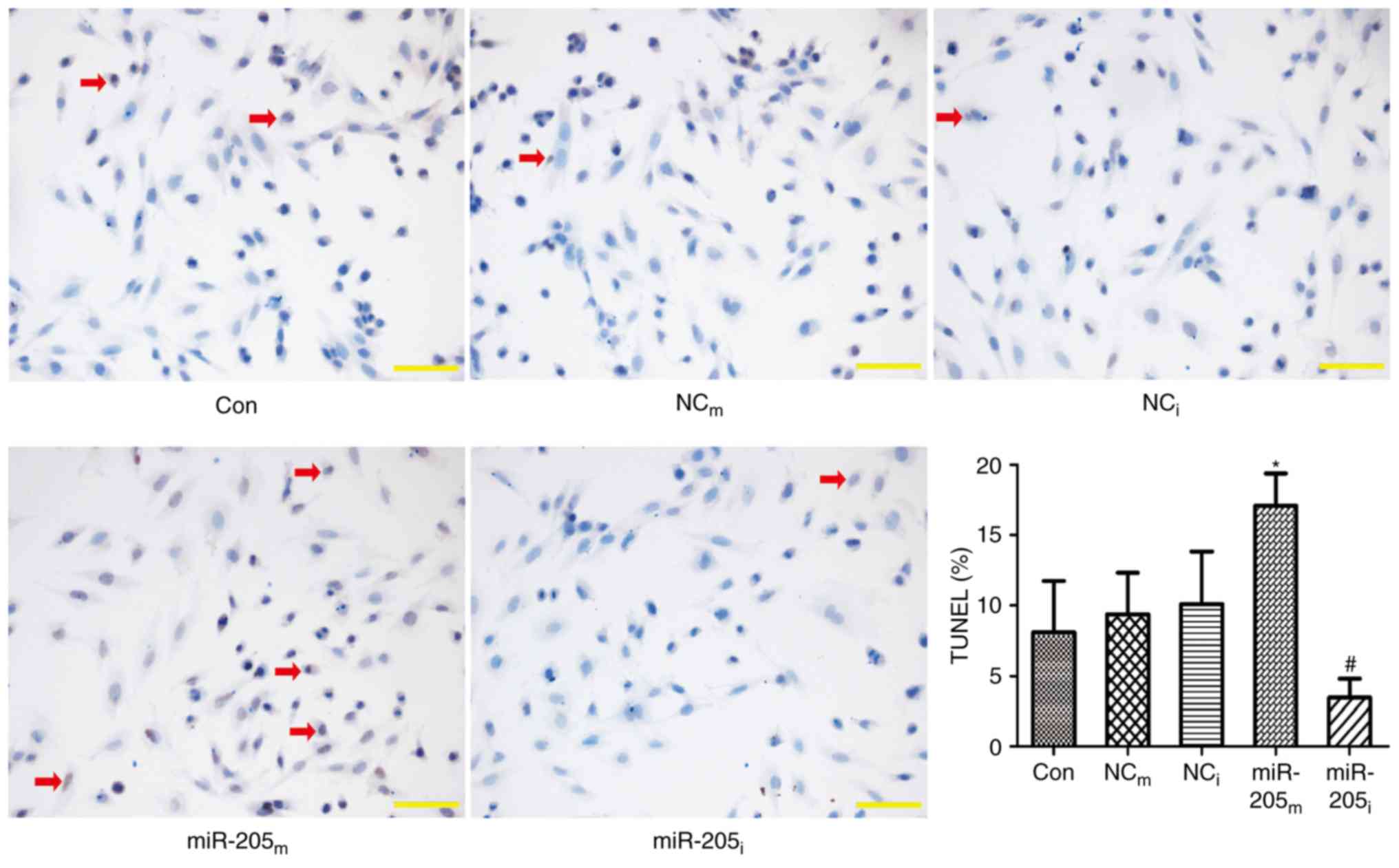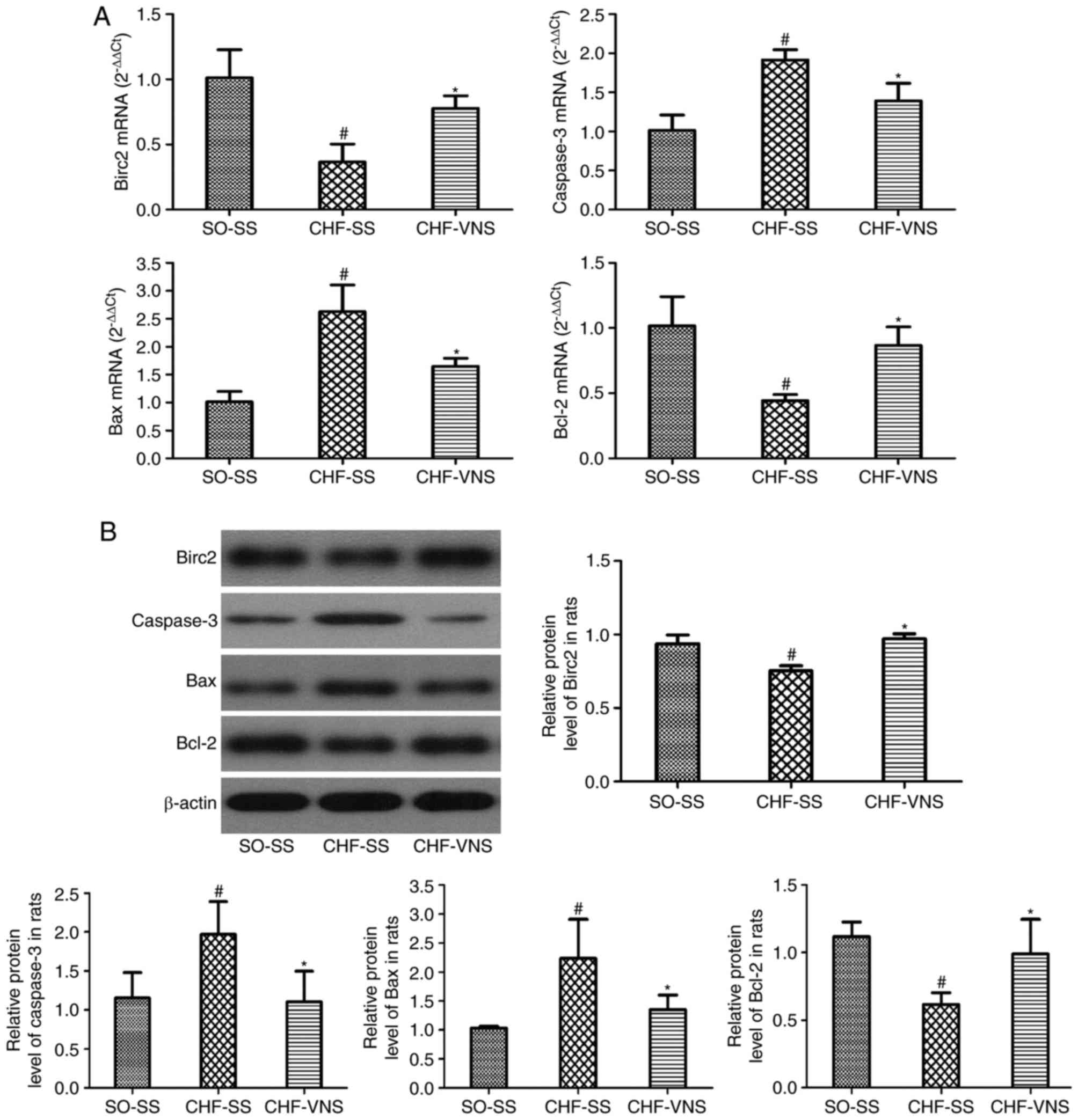|
1
|
Akat KM, Moore-McGriff D, Morozov P, Brown
M, Gogakos T, Da Rosa J Correa, Mihailovic A, Sauer M, Ji R,
Ramarathnam A, et al: Comparative RNA-sequencing analysis of
myocardial and circulating small RNAs in human heart failure and
their utility as biomarkers. Proc Natl Acad Sci USA.
111:11151–11156. 2014; View Article : Google Scholar : PubMed/NCBI
|
|
2
|
Schwartz PJ, De Ferrari GM, Sanzo A,
Landolina M, Rordorf R, Raineri C, Campana C, Revera M,
Ajmone-Marsan N, Tavazzi L and Odero A: Long term vagal stimulation
in patients with advanced heart failure: First experience in man.
Eur J Heart Fail. 10:884–891. 2008. View Article : Google Scholar : PubMed/NCBI
|
|
3
|
Sabbah HN, Ilsar I, Zaretsky A, Rastogi S,
Wang M and Gupta RC: Vagus nerve stimulation in experimental heart
failure. Heart Fail Rev. 16:171–178. 2011. View Article : Google Scholar : PubMed/NCBI
|
|
4
|
Zannad F, De Ferrari GM, Tuinenburg AE,
Wright D, Brugada J, Butter C, Klein H, Stolen C, Meyer S, Stein
KM, et al: Chronic vagal stimulation for the treatment of low
ejection fraction heart failure: Results of the neural cardiac
therapy for heart failure (NECTAR-HF) randomized controlled trial.
Eur Heart J. 36:425–433. 2015. View Article : Google Scholar : PubMed/NCBI
|
|
5
|
Li Y, Xuan YH, Liu SS, Dong J, Luo JY and
Sun ZJ: Short-term vagal nerve stimulation improves left
ventricular function following chronic heart failure in rats. Mol
Med Rep. 12:1709–1716. 2015. View Article : Google Scholar : PubMed/NCBI
|
|
6
|
Bartel DP: MicroRNAs: Genomics,
biogenesis, mechanism, and function. Cell. 116:281–297. 2004.
View Article : Google Scholar : PubMed/NCBI
|
|
7
|
Barringhaus KG and Zamore PD: MicroRNAs:
Regulating a change of heart. Circulation. 119:2217–2224. 2009.
View Article : Google Scholar : PubMed/NCBI
|
|
8
|
Cordes KR and Srivastava D: MicroRNA
regulation of cardiovascular development. Circ Res. 104:724–732.
2009. View Article : Google Scholar : PubMed/NCBI
|
|
9
|
Eulalio A, Mano M, Dal Ferro M, Zentilin
L, Sinagra G, Zacchigna S and Giacca M: Functional screening
identifies miRNAs inducing cardiac regeneration. Nature.
492:376–381. 2012. View Article : Google Scholar : PubMed/NCBI
|
|
10
|
Latronico MV and Condorelli G: MicroRNAs
and cardiac pathology. Nat Rev Cardiol. 6:419–429. 2009. View Article : Google Scholar : PubMed/NCBI
|
|
11
|
Olivetti G, Abbi R, Quaini F, Kajstura J,
Cheng W, Nitahara JA, Quaini E, Di Loreto C, Beltrami CA, Krajewski
S, et al: Apoptosis in the failing human heart. N Engl J Med.
336:1131–1141. 1997. View Article : Google Scholar : PubMed/NCBI
|
|
12
|
Wencker D, Chandra M, Nguyen K, Miao W,
Garantziotis S, Factor SM, Shirani J, Armstrong RC and Kitsis RN: A
mechanistic role for cardiac myocyte apoptosis in heart failure. J
Clin Invest. 111:1497–1504. 2003. View
Article : Google Scholar : PubMed/NCBI
|
|
13
|
Katz MG, Fargnoli AS, Williams RD, Kendle
AP, Steuerwald NM and Bridges CR: MiRNAs as potential molecular
targets in heart failure. Future Cardiol. 10:789–800. 2014.
View Article : Google Scholar : PubMed/NCBI
|
|
14
|
Xu C, Lu Y, Pan Z, Chu W, Luo X, Lin H,
Xiao J, Shan H, Wang Z and Yang B: The muscle-specific microRNAs
miR-1 and miR-133 produce opposing effects on apoptosis by
targeting HSP60, HSP70 and caspase-9 in cardiomyocytes. J Cell Sci.
120:3045–3052. 2007. View Article : Google Scholar : PubMed/NCBI
|
|
15
|
Tang Y, Zheng J, Sun Y, Wu Z, Liu Z and
Huang G: MicroRNA-1 regulates cardiomyocyte apoptosis by targeting
Bcl-2. Int Heart J. 50:377–387. 2009. View Article : Google Scholar : PubMed/NCBI
|
|
16
|
Liu SS, Xuan YH, Li Y, Dong J, Luo JY and
Sun ZJ: Short-term vagal nerve stimulation improves chronic heart
failure via miR-133a-3p upregulation in a rat model. Int J Clin Exp
Pathol. 10:50–60. 2017.
|
|
17
|
Cao JM, Fishbein MC, Han JB, Lai WW, Lai
AC, Wu TJ, Czer L, Wolf PL, Denton TA, Shintaku IP, et al:
Relationship between regional cardiac hyperinnervation and
ventricular arrhythmia. Circulation. 101:1960–1969. 2000.
View Article : Google Scholar : PubMed/NCBI
|
|
18
|
Gajarsa JJ and Kloner RA: Left ventricular
remodeling in the post-infarction heart: A review of cellular,
molecular mechanisms, and therapeutic modalities. Heart Fail Rev.
16:13–21. 2011. View Article : Google Scholar : PubMed/NCBI
|
|
19
|
Livak KJ and Schmittgen TD: Analysis of
relative gene expression data using real-time quantitative PCR and
the 2(-Delta Delta C(T)) method. Methods. 25:402–408. 2001.
View Article : Google Scholar : PubMed/NCBI
|
|
20
|
Salajegheh A, Vosgha H, Md Rahman A, Amin
M, Smith RA and Lam AK: Modulatory role of miR-205 in angiogenesis
and progression of thyroid cancer. J Mol Endocrinol. 55:183–196.
2015. View Article : Google Scholar : PubMed/NCBI
|
|
21
|
Guan B, Li Q, Li XH and Zhou XJ:
MicroRNA-205 targeted Kruppel-like factor 12 and regulated
MDA-MB-468 cells apoptosis in basal-like breast carcinoma. Zhonghua
Yi Xue Za Zhi. 96:2070–2075. 2016.(In Chinese). PubMed/NCBI
|
|
22
|
Tian L, Zhang J, Ge J, Xiao H, Lu J, Fu S,
Liu M and Sun Y: MicroRNA-205 suppresses proliferation and promotes
apoptosis in laryngeal squamous cell carcinoma. Med Oncol.
31:7852014. View Article : Google Scholar : PubMed/NCBI
|
|
23
|
Gaddam KK, Verma A, Thompson M, Amin R and
Ventura H: Hypertension and cardiac failure in its various forms.
Med Clin North Am. 93:665–680. 2009. View Article : Google Scholar : PubMed/NCBI
|
|
24
|
Schannwell CM, Hennersdorf MG and Strauer
BE: Hypertension and cardiac failure. Internist (Berl). 48:909–920.
2007.(In German). View Article : Google Scholar : PubMed/NCBI
|
|
25
|
McMurray JJ, Adamopoulos S, Anker SD,
Auricchio A, Böhm M, Dickstein K, Falk V, Filippatos G, Fonseca C,
Gomez-Sanchez MA, et al: ESC Guidelines for the diagnosis and
treatment of acute and chronic heart failure 2012: The task force
for the diagnosis and treatment of acute and chronic heart failure
2012 of the European Society of Cardiology. Developed in
collaboration with the Heart Failure Association (HFA) of the ESC.
Eur Heart J. 33:1787–1847. 2012. View Article : Google Scholar : PubMed/NCBI
|
|
26
|
Hamann JJ, Ruble SB, Stolen C, Wang M,
Gupta RC, Rastogi S and Sabbah HN: Vagus nerve stimulation improves
left ventricular function in a canine model of chronic heart
failure. Eur J Heart Fail. 15:1319–1326. 2013. View Article : Google Scholar : PubMed/NCBI
|
|
27
|
De Ferrari GM, Crijns HJ, Borggrefe M,
Milasinovic G, Smid J, Zabel M, Gavazzi A, Sanzo A, Dennert R,
Kuschyk J, et al: Chronic vagus nerve stimulation: A new and
promising therapeutic approach for chronic heart failure. Eur Heart
J. 32:847–855. 2011. View Article : Google Scholar : PubMed/NCBI
|
|
28
|
Premchand RK, Sharma K, Mittal S, Monteiro
R, Dixit S, Libbus I, DiCarlo LA, Ardell JL, Rector TS, Amurthur B,
et al: Autonomic regulation therapy via left or right cervical
vagus nerve stimulation in patients with chronic heart failure:
Results of the ANTHEM-HF trial. J Card Fail. 20:808–816. 2014.
View Article : Google Scholar : PubMed/NCBI
|
|
29
|
Li X, Zhang X, Wang T, Sun C, Jin T, Yan
H, Zhang J, Li X, Geng T, Chen C, et al: Regulation by bisoprolol
for cardiac microRNA expression in a rat volume-overload heart
failure model. J Nanosci Nanotechnol. 13:5267–5275. 2013.
View Article : Google Scholar : PubMed/NCBI
|
|
30
|
Tolonen AM, Magga J, Szabó Z, Viitala P,
Gao E, Moilanen AM, Ohukainen P, Vainio L, Koch WJ, Kerkelä R, et
al: Inhibition of Let-7 microRNA attenuates myocardial remodeling
and improves cardiac function postinfarction in mice. Pharmacol Res
Perspect. 2:e000562014. View
Article : Google Scholar : PubMed/NCBI
|
|
31
|
Wong LL, Armugam A, Sepramaniam S,
Karolina DS, Lim KY, Lim JY, Chong JP, Ng JY, Chen YT, Chan MM, et
al: Circulating microRNAs in heart failure with reduced and
preserved left ventricular ejection fraction. Eur J Heart Fail.
17:393–404. 2015. View
Article : Google Scholar : PubMed/NCBI
|
|
32
|
Kuosmanen SM, Hartikainen J, Hippeläinen
M, Kokki H, Levonen AL and Tavi P: MicroRNA profiling of
pericardial fluid samples from patients with heart failure. PLoS
One. 10:e01196462015. View Article : Google Scholar : PubMed/NCBI
|
|
33
|
Wiklund ED, Bramsen JB, Hulf T, Dyrskjøt
L, Ramanathan R, Hansen TB, Villadsen SB, Gao S, Ostenfeld MS,
Borre M, et al: Coordinated epigenetic repression of the miR-200
family and miR-205 in invasive bladder cancer. Int J Cancer.
128:1327–1334. 2011. View Article : Google Scholar : PubMed/NCBI
|
|
34
|
Schaefer A, Jung M, Mollenkopf HJ, Wagner
I, Stephan C, Jentzmik F, Miller K, Lein M, Kristiansen G and Jung
K: Diagnostic and prognostic implications of microRNA profiling in
prostate carcinoma. Int J Cancer. 126:1166–1176. 2010.PubMed/NCBI
|
|
35
|
Karaayvaz M, Zhang C, Liang S, Shroyer KR
and Ju J: Prognostic significance of miR-205 in endometrial cancer.
PLoS One. 7:e351582012. View Article : Google Scholar : PubMed/NCBI
|
|
36
|
Matsushima K, Isomoto H, Yamaguchi N,
Inoue N, Machida H, Nakayama T, Hayashi T, Kunizaki M, Hidaka S,
Nagayasu T, et al: MiRNA-205 modulates cellular invasion and
migration via regulating zinc finger E-box binding homeobox 2
expression in esophageal squamous cell carcinoma cells. J Transl
Med. 9:302011. View Article : Google Scholar : PubMed/NCBI
|
|
37
|
Son DJ, Kumar S, Takabe W, Kim CW, Ni CW,
Alberts-Grill N, Jang IH, Kim S, Kim W, Won Kang S, et al: The
atypical mechanosensitive microRNA-712 derived from pre-ribosomal
RNA induces endothelial inflammation and atherosclerosis. Nat
Commun. 4:30002013. View Article : Google Scholar : PubMed/NCBI
|
|
38
|
Kim CW, Kumar S, Son DJ, Jang IH,
Griendling KK and Jo H: Prevention of abdominal aortic aneurysm by
anti-microRNA-712 or anti-microRNA-205 in angiotensin II-infused
mice. Arterioscler Thromb Vasc Biol. 34:1412–1421. 2014. View Article : Google Scholar : PubMed/NCBI
|
|
39
|
Zhang G, Hou X, Li Y and Zhao M: MiR-205
inhibits cell apoptosis by targeting phosphatase and tensin homolog
deleted on chromosome ten in endometrial cancer Ishikawa cells. BMC
Cancer. 14:4402014. View Article : Google Scholar : PubMed/NCBI
|
|
40
|
Meier P, Finch A and Evan G: Apoptosis in
development. Nature. 407:796–801. 2000. View Article : Google Scholar : PubMed/NCBI
|
|
41
|
LaCasse EC, Baird S, Korneluk RG and
MacKenzie AE: The inhibitors of apoptosis (IAPs) and their emerging
role in cancer. Oncogene. 17:3247–3259. 1998. View Article : Google Scholar : PubMed/NCBI
|
|
42
|
Warnakulasuriyarachchi D, Cerquozzi S,
Cheung HH and Holcik M: Translational induction of the inhibitor of
apoptosis protein HIAP2 during endoplasmic reticulum stress
attenuates cell death and is mediated via an inducible internal
ribosome entry site element. J Biol Chem. 279:17148–17157. 2004.
View Article : Google Scholar : PubMed/NCBI
|
|
43
|
Hamanaka RB, Bobrovnikova-Marjon E, Ji X,
Liebhaber SA and Diehl JA: PERK-dependent regulation of IAP
translation during ER stress. Oncogene. 28:910–920. 2009.
View Article : Google Scholar : PubMed/NCBI
|
|
44
|
Kirsch DG, Doseff A, Chau BN, Lim DS, de
Souza-Pinto NC, Hansford R, Kastan MB, Lazebnik YA and Hardwick JM:
Caspase-3-dependent cleavage of Bcl-2 promotes release of
cytochrome c. J Biol Chem. 274:21155–21161. 1999. View Article : Google Scholar : PubMed/NCBI
|













